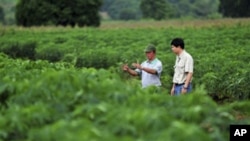Insects have long plagued farmers as they try to grow food for themselves and others. History is filled with tales of crop failures because of pests. Chemicals have been widely used for decades to combat the problem. But the practice is not always friendly to the environment or healthy for those who eat treated produce.
An approach called Integrated Pest Management is helping to address these issues and has successfully increased crop production in Asia and elsewhere. The U.S. Environmental Protection Agency defines Integrated Pest Management, or IPM, as an effective and environmentally sensitive approach to pest management that relies on a combination of common-sense practices.
IPM programs use current, comprehensive information on the life cycles of pests and their interaction with the environment.
Brenda Vander Mey is a professor of Sociology at Clemson University who specializes in social aspects of farming. "Integrated pest management programs thrive in much of Asia," she said. "The integrated pest management has been extremely successful for decades now in Indonesia. Crop rotation is one of the strategies for integrated pest management. It is one of many. But what you cannot do is just continuously work soil and work soil without putting something back, some organic matter."
IPM is not a single pest control method but, rather, a series of pest management evaluations, decisions and controls. IPM also varies from organic food growing, which applies many of the same concepts as IPM, but limits the use of pesticides to those that are produced from natural sources.
James Frederick, a professor at the Pee Dee Research and Education Center in Florence, South Carolina, explains some of the basic steps used in IPM. "They might be able to plant early. If you know a disease comes in or an insect comes in late in the growing season, so you try to plant early as you can so most of the crop will be made by the time disease or insects come in. You can do crop rotation. It is a good example of a basic practice you can do to help with weed control."
Not all insects, weeds, and other living organisms require control. Many organisms are innocuous, and some are even beneficial. IPM programs work to monitor for pests and identify them accurately.
Professor Frederick says farmers also need to know what is best to plant. "Sometimes when you develop a variety resistant to a disease, you will lose a little bit of yield. So normally you would not plant that variety that has that disease resistance unless you have the problem," he said. "If you know you are going to have a problem, then you are going to plant that variety that is resistant to that disease. Then of course the last option is some sort of chemical control. But we try to tell our farmers to use management first and chemicals second," Professor Frederick said.
Genetics is also helping to play a role in developing crops that are more resistant to disease and insects. But Professor Brenda Vander Mey says modified crops are not universally welcomed.
"There is a horrendous debate about the role that biotechnology or engineered foods and foodstuffs could play in decreasing hunger, food insecurity, etc. The big issue has become should it have a role given concerns that people have over genetically engineered food and foodstuffs and their potential impact on environment and people. So the debate just continues in that area, with some countries less comfortable than others with adopting the more genetically engineered germ plasmas, etc. for production."
But she adds improvements in plants can be very beneficial. "It could be the engineering is such that it is bringing say more beta carotene into the rice. Or it could be engineered such that the plants are more pest resistant than previously," Vander Mey said. "And on balance, I think that people are far more comfortable with genetically engineered foods that stick within their own category."
Integrated Pest Management is a complex pest control process, and specific plans need to be developed to suit specific needs. One IPM definition does not apply to all foods and all areas.
Professor James Frederick says even small farmers can benefit simply by paying attention to their immediate environment. "One basic and easy practice for integrated pest management is to go out there and scout and see what the problems are rather than say 'ok, it is about that time of the year when something should show up. Therefore I am going to go out and spray whether it is out there or not,'" he said.
In the United States, food grown using IPM practices is not usually identified in the marketplace similar to organic food. Produce grown using IPM methods do not have a national certification as the U.S. Department of Agriculture has developed for organic foods.










